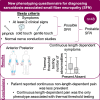New phenotyping questionnaire for diagnosing sarcoidosis-associated small fiber neuropathy
- PMID: 39291161
- PMCID: PMC11406462
- DOI: 10.1093/braincomms/fcae289
New phenotyping questionnaire for diagnosing sarcoidosis-associated small fiber neuropathy
Abstract
Small fiber neuropathy is a common complication in patients with sarcoidosis and its prevalence is estimated at 40-86%. The underlying mechanism influences the presentation of small fiber neuropathy. For example, patients with metabolic diseases are often associated with a classic length-dependent small fiber neuropathy pattern, while patients with inflammatory diseases are more often present with a non-length-dependent small fiber neuropathy. Detailed phenotyping may be useful to improve diagnostic efficiency, as a clue to underlying mechanisms and as a precondition for personalized medicine. This study examined four phenotypes distinguishing between length-dependent and non-length-dependent presentation with a new subdivision for continuous and intermittent presentation. Forty-eight sarcoid patients with symptoms and at least two clinical signs of small fiber neuropathy and normal nerve conduction studies were classified as having probable small fiber neuropathy. A new small fiber neuropathy phenotyping questionnaire has been developed that allows patients to mark the anatomical locations of pain at three different levels: the skin, muscles, and joints. The location of symptoms was used to define length dependence, and two colors were used to distinguish continuous (red) from intermittent (blue) symptoms. In addition, skin biopsy, corneal confocal microscopy, Sudoscan and water immersion skin wrinkling were used to investigate a correlation between the four phenotypes, sensory function, nerve fiber density, and autonomic nerve function. Overall, 35% of patients with probable small fiber neuropathy showed length-dependent symptoms and 44% showed non-length-dependent symptoms while 21% suffered from non-neuropathic musculoskeletal pain. The distinction between intermittent and continuous symptoms showed significantly less continuous than intermittent non-length-dependent symptoms (odds ratio = 0.3, P = 0.01). Moreover, continuous length-dependent symptoms were the only phenotype that correlated with thermal threshold testing (R = 0.3; P = 0.02) and the small fiber neuropathy screening list (R = 0.3; P = 0.03). In addition, thermal threshold testing (TTT) also correlated with the small fiber neuropathy (SFN) screening list (R = 0.3; P = 0.03). Other diagnostic methods showed no correlation with any of the four defined phenotypes. A novel finding is that TTT is only associated with continuous length-dependent pain, suggesting that TTT could result in more false negatives in patients with other pain phenotypes. Determining the pathophysiologic mechanisms could help develop new diagnostic methods. If patients suspected of SFN show symptoms without a length-dependent continuous presentation, the diagnosis should focus less on the diagnostic methods used.
Keywords: SFNSL; nerve fiber density; pain; sensory testing; thermal threshold testing.
© The Author(s) 2024. Published by Oxford University Press on behalf of the Guarantors of Brain.
Conflict of interest statement
Each author declares that he or she has no commercial associations (e.g. consultancies, stock ownership, equity interest, patent/licensing arrangement, etc.) that might pose a conflict of interest in connection with the submitted article.
Figures





Similar articles
-
Thermal threshold testing: call for a balance between the number of measurements and abnormalities in the diagnosis of sarcoidosis-associated small fiber neuropathy.Pain Rep. 2023 Sep 4;8(5):e1095. doi: 10.1097/PR9.0000000000001095. eCollection 2023 Sep. Pain Rep. 2023. PMID: 37674973 Free PMC article.
-
Quantification of small fiber pathology in patients with sarcoidosis and chronic pain using cornea confocal microscopy and skin biopsies.J Pain Res. 2017 Aug 26;10:2057-2065. doi: 10.2147/JPR.S142683. eCollection 2017. J Pain Res. 2017. PMID: 28894389 Free PMC article.
-
Clinical, histologic, and immunologic signatures of Small Fiber Neuropathy in Systemic Lupus Erythematosus.J Peripher Nerv Syst. 2024 Sep;29(3):315-328. doi: 10.1111/jns.12644. Epub 2024 Jul 9. J Peripher Nerv Syst. 2024. PMID: 38981675
-
Intraepidermal Nerve Fiber Density as Measured by Skin Punch Biopsy as a Marker for Small Fiber Neuropathy: Application in Patients with Fibromyalgia.Diagnostics (Basel). 2021 Mar 17;11(3):536. doi: 10.3390/diagnostics11030536. Diagnostics (Basel). 2021. PMID: 33802768 Free PMC article. Review.
-
Corneal Confocal Microscopy in the Diagnosis of Small Fiber Neuropathy: Faster, Easier, and More Efficient Than Skin Biopsy?Pathophysiology. 2021 Dec 26;29(1):1-8. doi: 10.3390/pathophysiology29010001. Pathophysiology. 2021. PMID: 35366285 Free PMC article. Review.
References
-
- Lacomis D. Small-fiber neuropathy. Muscle Nerve. 2002;26(2):173–188. - PubMed
-
- Bakkers M, Faber CG, Hoeijmakers JGJ, Lauria G, Merkies ISJ. Small fibers, large impact: Quality of life in small-fiber neuropathy. Muscle Nerve. 2014;49(3):329–336. - PubMed
-
- Voortman M, Fritz D, Vogels OJM, et al. Small fiber neuropathy: A disabling and underrecognized syndrome. Curr Opin Pulm Med. 2017;23(5):447–457. - PubMed
LinkOut - more resources
Full Text Sources
Research Materials
Miscellaneous
